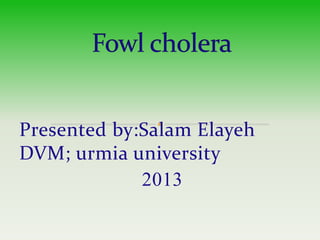
Fowl cholera. clinical signs,diagnosis, treatment, vaccination and prevention.by salam elayh
- 1. Presented by:Salam Elayeh DVM; urmia university 2013
- 2. Fowl cholera is a highly contagious disease of domestic and wild birds.Sudden death because of diarrhea→just like man cholera. Importance:1-economicly.2-historical (pasteur) 3- biological:wild birds
- 4. Gram-negative, non-spore-forming, rod shaped bi polar Bacteria
- 6. Attack many kinds of birds as like as: Fowl,Turkey,Duck,Geese,wild bird,water fowl. Turkey are more sensitive than each others.Some domestic mammals are olso susceptible
- 7. Morbidity:10-80 Mortality:turkey →68 duck→50 poultry→15-50 Age: older than 16 w in layer 4-5 w in broiler Season:autumn and winter
- 8. Enterance: 1-URT mucosal membrane 2-conjunctiva 3-cutaneous wounds Incubation period:4-9 days
- 9. 1. start of acute septicemia with coagulopaties 2.production of endotoxin →oedema , haemorrhagia ,shock,sudden deaths 3.bacteraemia→spreading to lung 4.influencing factors →1- crowding, 2-clima,3- concurrent infection 4-nutrition,5- biosecurity, 6-injury and stress
- 10. 1.Direct contact or aerosol (excretes) source → latently infected or chronic sick birds location of infection → URT and nasal cavity 2.Indirectly → personnel and equipment, vectors →pigs, cattle, cats, wild birds, rodents, insects Incubation period→4-9 days
- 13. Chronic course Failure of growth and developement of body Drop in egg production Swelling of wattles, sinuses Swelling of joints, foot pad, sternal bursa Torticolis Dermal necrosis in turkey Granulomatous dermatitis in pigeons and birds of prey
- 14. In the chronic form of fowl cholera, suppurative lesions may be found in a variety of locations. In this broiler breeder, severe swelling of the infraorbital sinuses is found on external examination .
- 15. Acute form Petechia to ecchymosis on serosis and mucous membrane exsudative pneumonia Sub acute form Petechia to ecchymosis in intestine, heart,lungs exsudate in pericard and body cavity swollen liver, coagulative necrosis(corn meal liver) in turkey → frequently exsudative pneumonia In turkey → flaccid, puckered a hyperemic follicle on ovary
- 16. Fowl cholera. Small areas of necrosis in the liver (corn meal liver)
- 17. hyperemic
- 18. Hemorrhage in heart muscle Haemorrhages in intestine (different extent)
- 19. Wattle form, artritis, osteomyelitis Exsudative serositis sinusitis
- 20. Purulent exudate may be found within the facial swellings
- 21. The foot has been incised to show a caseous exudate .
- 22. 1.history, sings and lesions 2.bacteriology 3.indentification by using biochemical test 4.now is available PCR test 5.bipolar microorganismus by bluedomethylene staining 6.Serology AGID or ELISA, better for evaluation of vaccine response
- 23. Bluedomethylene,lichman,gimsa staining→bipolar bacteria Heart and livers blood Culture in : dextrose starch agar +5%serum Morphology on D.S.A: 1- Fluorescent→high virolent 2-sectored colony→mild 3-blue or slightly fluorescent→low 4-non fluorescent→non pathogene MUSSY ODOR
- 24. 1.Infectious coryza 2.Fowl typhoid 3.Fowl plague(avian flu) 4.Duck plaque(duck herpes virus 1) 5.Otherpaseurellas(p.haemolitica,p.gallinarm)
- 26. 1 -live attenuated 2-in activated : razi institute A: 1 Best→(-):1,3,4 Age : 8-10 and 18-20 w In poultry →IM In turkey →DW
- 28. Thanks
